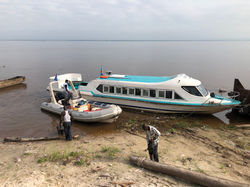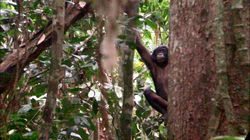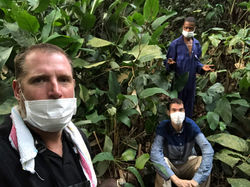
EXPEDITION WILD

In Search of The Bonobo Chimpanzee.
Democratic Republic of Congo
Expedition Basics:
In April 2019 we managed to put together a small group of interested parties to investigate and evaluate the tourism potential of a community conservation initiative in the DRC - know as Mbou Mon Tour (MMT).
The site is located 180km up river from the capital city of Kinshasa along the mighty Congo River.
We travel by boat from Kinshasa to the village of Tshumbiri, where we had arranged a 4x4 vehicle to take us another 60km's "inland" on what was at one stage a road but has now largely become overgrown with only a single bicycle and motorbike track defining the route. Not many travellers venture this far it seems.
Overview:
Mbou Mon Tour (MMT) conservation area is made up of open savannah grasslands mixed with dense forest areas. The forest sections belong to several communities that MMT with the Help of the WWF have worked hard to conserve.
The history of this initiative goes back to 1997 when an increase in migrants labour into the area resulted in the killing and eating of the bonobos which is traditionally not the case with the local people of the area. This caused concern and one local resident and now founder of MMT took it upon himself to try and get some protection for the Bonobos. He originally approached Government but at the time it was generally believed that Bobobos did not live in this mosaic forest savannah and thus largely ignored. It was only through determination that in 2002 with the help of the WWF that their presence was verified. This lead to the formation of the MMT, and in 2008 the WWF and other sponsors supported the program that has now seen 6 Bonobo groups being actively monitored with 3 groups that have had extensive habituation, and at least one group that is part of an ongoing research study with various International institutions.
 |  |  |
|---|---|---|
 |  |  |
 |
Into the forest we go:
We started each day anything from 3:30am to 4:30am depending which group of bonobos we where visiting. The first morning we left by motorbike on a short 15min ride, and the second day was a much longer 1hr:30min drive by vehicle. At both sites we had a relatively short walk (15 -30min) to get to the nesting sites where the bonobos could be seen still rolled up in their make shift nests. The idea of arriving early before sunrise, was largely to locate the groups in their nesting sites before they got mobile for the day. These location are marked each evening by GPS as part of the ongoing programme which the community researchers manage. It was really an incredible experience and especially because without the few dedicated individuals and the support of the villagers, this population would just not exist.
 |  |  |
|---|---|---|
 |  |  |
 |  |  |
Bonobos are closely related to chimpanzees but are only found south of the Congo River, which forms a major geographic boundary between the populations. Bonobos are also different from chimpanzees and show distinct key social and sexual behaviours that seem to show a greater affiliation with humans than they do with each other.
The bonobo population in the area under MMT is estimated between 180 - 250 individuals with groups as large as 50+. We were also informed on several occasions that this area has a significantly high bonobo population relative to other areas, but I was unable to verify this fact. Regardless the mosaic landscape certainly has its advantages in separating these bonobo communities and thus easier to reach, also it would seem that the resident bonobos home ranges are relatively small meaning they are always within a relatively small area (Est. 1500ha – not verified) and with the many forest, savannah margins it makes for relatively easy access.